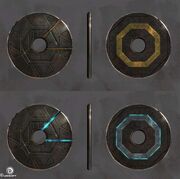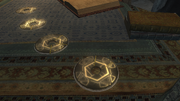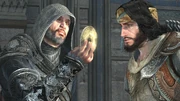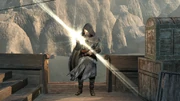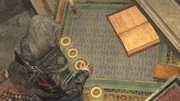- Niccolò: "Artifacts?"
- Altaïr: "Of a kind. They are keys, each one imbued with a message."
- —Niccolò Polo and Altaïr Ibn-La'Ahad on the Masyaf Keys.[src]
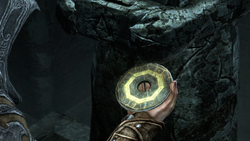
Ezio holding one of the Masyaf Keys
The Masyaf Keys, also referred to as the seals or keys of Altaïr, were a collection of five First Civilization Memory Seals containing information and memories from the Mentor of the Levantine Assassins, Altaïr Ibn-La'Ahad, their original owner.
When brought together, the keys would grant access to the library of Altaïr Ibn-La'Ahad in the fortress of Masyaf,[1] which was desired by both the Assassins and the Templars during the early 16th century.[2]
History
Altaïr's discovery
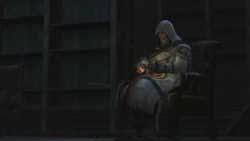
Altaïr holding a Memory Seal
Following the death of his wife and youngest son, and his deposition at the hands of Abbas Sofian, Altaïr entered into exile in the Assassin fortress of Alamut. During this time, Altaïr was directed to six Memory Seals by the Apple of Eden that he had in his possession; he retrieved these artifacts and hid them.[1]
Altaïr's research discovered that the seals contained messages, though he did not know to whom they were intended.[1] He would later imbue the six seals with his own memories, and make use of five of them as the keys of his library.[2]
In 1257, whilst Masyaf was about to be besieged by the Mongols, Altaïr passed the five keys and his codex to his guests, merchants Niccolò and Maffeo Polo, who promised to hide them. They then escaped from the Mongols with the help of Altaïr's son Darim and safely arrived in their home city of Constantinople, where they hid the keys and formed an Assassins Guild, though they lost Altaïr's Codex to the Mongol Empire along the way.[1]
Ezio's acquisition
In 1509, Ezio Auditore da Firenze, Mentor of the Italian Assassins, learned of the existence of Altaïr's library and its keys after reading a document left behind by his late father, Giovanni. Curious and driven by a desire to obtain answers about his Order, Ezio left Rome for Masyaf in 1510.[2]
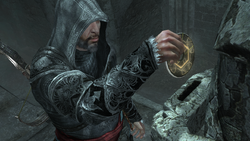
Ezio retrieving a key from a statue
Ezio arrived in Masyaf in early 1511, at which point Niccolò Polo's journal – containing information on the keys – had come into the possession of the Templar Leandros, the captain of a group of Byzantine remnants. After a long struggle, Ezio was able to kill Leandros and obtain the book.[2]
Following this, Ezio journeyed to Constantinople, where he started his search for the keys and eventually found one underneath Niccolò Polo's old trading post. By that point, however, the trading post was inhabited by the Venetian bookseller Sofia Sartor. With her assistance, Ezio was able to decode a map showing the locations of all the keys in Constantinople.[2]
With every key that Ezio found, he found himself reliving a significant moment of Altaïr's life, of which the Syrian Assassin had encoded onto the key during his own lifetime. In time, Ezio recovered all five keys, including the one that the Templars had in their possession, and returned to Masyaf in order to open the library.[2]
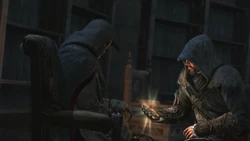
Ezio discovering the final Memory Seal
Inside, Ezio found no books or weapons as he and his Templar enemies had believed they would, but the skeleton of Altaïr holding his sixth and final seal. This showed him the final moments of Altaïr's life, and revealed that Ezio's Apple of Eden and Altaïr's own were not one and the same, as he had previously believed.[2]
Thus, ending his journey, Ezio stripped himself of his battle gear and Hidden Blades, renouncing his life as an Assassin. Ezio and Sofia then returned to Constantinople in order to hide the seals in the chamber beneath Sofia's former bookshop, within the Yerebatan Cistern, and under the protection of the city's Assassins.
Trivia
- The markings on Memory Seals are similar, if not identical, to a symbol shown in the Vatican Vault at the end of Assassin's Creed II. When Minerva spoke of the Temples, she showed Ezio an image of a step pyramid, above which was a symbol resembling one of the keys.
Gallery
References
| |||||||||||||||||||||||||||||||||||||

